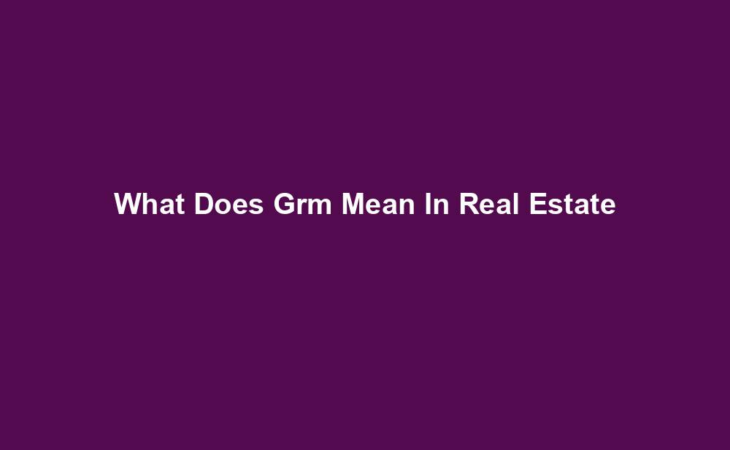
The abbreviation “GRM” stands for Gross Rent Multiplier in real estate. It is a metric used to evaluate the value of an investment property. The GRM is calculated by dividing the property’s sale price by its annual gross rental income. A lower GRM indicates a potentially better investment opportunity, as it suggests a higher income relative to the purchase price. Real estate professionals use GRM as a quick way to compare different properties and determine their potential for generating rental income.
In the world of real estate, understanding the jargon is key to navigating the market successfully. One term that often comes up is GRM, but what does it really mean? GRM stands for Gross Rent Multiplier, and it is an important metric used by investors and property professionals to assess the value of income-producing properties. But how exactly does this metric work?
GRM is calculated by dividing the purchase price of a property by its gross rental income. This provides a quick and easy way to determine the potential return on investment of a property. A lower GRM indicates a higher value and better investment opportunity, while a higher GRM may suggest a property is overpriced or has lower income potential. Understanding the GRM of a property allows buyers and sellers to make informed decisions and negotiate deals based on the property’s income-generating potential.
In the world of real estate, there are numerous acronyms and terms that can be confusing for both buyers and sellers. One such acronym is GRM, which stands for Gross Rent Multiplier. So, what does GRM mean in real estate? Essentially, GRM is a ratio used to determine the value of an income-producing property based on its gross rental income. By understanding the concept of GRM, investors and real estate professionals can make more informed decisions when it comes to buying or selling properties.
GRM is a simple and straightforward calculation that can provide valuable insights into the potential profitability of a property. It is calculated by dividing the purchase price or current market value of a property by its gross rental income. The gross rental income refers to the total amount of rent collected from tenants before deducting any expenses or vacancies. The resulting ratio, known as the GRM, provides an estimate of how many years it would take for the property’s gross rental income to pay for the property itself.
The concept of GRM is particularly useful when comparing similar income-producing properties. For example, if two properties have similar gross rental incomes but different purchase prices, calculating their respective GRMs can help determine which property offers a better investment opportunity. A lower GRM indicates a higher potential return on investment, while a higher GRM suggests a lower potential return. However, it’s important to note that GRM is just one factor to consider when evaluating a property’s investment potential, and other factors such as location, expenses, and market conditions should also be taken into account.
Now that we understand the basic concept of GRM, let’s delve into the steps involved in calculating it. To calculate GRM, you need the purchase price or market value of the property and its gross rental income. Here’s the formula:
| Purchase Price or Market Value of Property | ÷ | Gross Rental Income |
| GRM |
Let’s take an example to illustrate this calculation. Suppose you have a property with a purchase price of $500,000 and a gross rental income of $60,000 per year. To calculate GRM, you would divide $500,000 by $60,000, resulting in a GRM of approximately 8.33. This means it would take around 8.33 years for the property’s gross rental income to pay for itself.
Keep in mind that GRM is a simplified metric and does not take into account expenses such as property taxes, insurance, and maintenance. These costs must be factored in separately when evaluating the overall profitability of an investment property. Additionally, it’s worth noting that GRM calculations can vary depending on local market conditions and industry practices, so it’s essential to consider the specific factors relevant to your area.
GRM can be a valuable tool for property analysis and investment decision-making. Here are a few ways in which GRM can be used:
While GRM is a useful tool for property analysis, it’s essential to understand its limitations. Here are a few limitations to consider:
Despite these limitations, GRM remains a valuable metric for understanding the potential income-generating capacity of a property and comparing different investment opportunities.
GRM, or Gross Rent Multiplier, is a common metric used in real estate to evaluate the potential profitability of an investment property. It is calculated by dividing the property’s purchase price by its gross annual rental income.
For example, if a property costs $500,000 and generates $50,000 in annual rental income, the GRM would be 10. This means that it would take 10 years to recoup the purchase price through rental income alone.